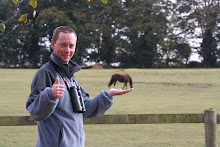Well it has been a pretty good week, starting with last weekend. The original plan was to head down to Cornwall for a long weekend of seawatching but following correspondance with one of the locals, the weather forecast was rubbish fo seabirds so I stayed at home.
Despite early rain on Sunday morning I managed to get my nets open in the garden by half nine and was soon catching birds. A greenfinch tape certainly helped as the birds were piling into the garden and at one time I had 17 in one net! By 11:30 I realised that I hadn't been back in the house! By lunchtime things had gone quiet but I had still managed 44 new, mainly greenfinch, and 5 re-traps including another of our nestbox great tits.
The arrival of several greenish warblers and wrynecks along the coast on Tuesday encouraged me to spend my day off (Wednesday) birding along the coast. First stop was the reserve. Despite it still being thick fog at 6am there didn't seem to be very much about. The dunes produced 2 turtle doves but at Thornham Point the highlights were 4 magpie, 2 woodpigeon and a reed bunting!! The fresh marsh was better with heaps of waders.
The gardens and coastal scrub along the coast path between Brancaster and Burnham Deepdale have always looked good for migrants and I have spent a few hours looking for stuff in the autumn with a single yellow-browed found so far. Things were not looking great as I had almost got to Brancaster Staithe before seeing a bird! A tit flock was moving along the hedgeline so I tried a bit pf pishing and pulled them in. Most of the birds were long-tails but there was also several blackcap, lesser whitethroat and a couple of chiffchaffs. A warbler flicked overhead into some large willows and showed long enough for the bold eyestripe to stand out - my own greenish warbler!! The bird was very elusive and it took another 20mins before I had better views including the short wingbar and eyestripe. The bird was seeming to favour the same group of trees and I put the news out. I saw the bird again several times over the next 50mins but by the time other people had arrived it had moved on.
Hopefully the rest of the autumn will be as successful!
Monday, 29 August 2011
Friday, 19 August 2011
Now the juv ruff are coming through in numbers, the annual weekly claims of buff breasted sand have started so when one came over the radio yesterday afternoon I was slightly sceptical. I was asked to go to Parrinder Hide to check a wader that people thought was a buff breast. The description over the radio on the way down sounded like ruff so I was pretty surprised to find a buff breasted sandpiper feeding within 10m of the hide!! The hide was buzzing with excitement especially as the bird was getting closer and ended up within 10ft feeding with 10 ruff, 20 dunlin and a cracking juv curlew sand.
Despite the disturbance with the coastal project and our management work, the fresh marsh is looking awesome. This afternoon there were 100 dunlin, 60 ringed plover, 45 ruff, 4 curlew sands, 2 green sands, greenshank, juv arctic tern, spoonbill plus the buff breast - I can't wait to see the place pulls in next autumn once the work has finished.
With the small arrival of passerines yesterday I decided to check Thornham Point but the weather had cleared up too quickly with the only thing of note an adult turtle dove flushed from the dunes.
Tuesday, 2 August 2011
Ringing has been pretty amazing with over 150 birds rung over the last 2 weekends. Mostly tits but there has been a few goodies including this lesser whitethroat, 3 whitethroat, 4 treecreeper and a juv jay. A green sand and greeshank were on the new lake this Saturday and a singing turtle dove the week before.
Juv green woodpecker - a ringing tick for me. There has been at least 3 birds in the wood recently so it was nice to finally catch one.
Juv chiffchaff in the garden. A nice surprise considering how slow it has been in the garden this month with the windy conditions. Only 22 new of which 12 were ringed on Sunday.
This bird was singing nearby so I put on a tape. Within 5 mins I saw movement near the nets and found this cracker in the bottom shelf!
Cimbex connatus or alder sawfly - the beast (nearly 1 inch long) was brought into the visitor centre last week. All the sawfly species are under-recorded although the larval forms were found on the reserve last year. Although they are now spreading, they went unrecorded in the UK for 90 years until 1997. Since then there has been a increase in records throughout southern Britain.
Subscribe to:
Posts (Atom)





